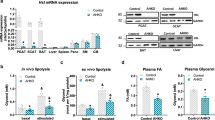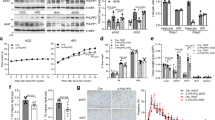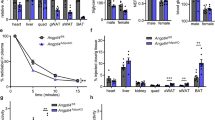Abstract
Obesity is a disorder of energy balance1. Hormone-sensitive lipase (HSL) mediates the hydrolysis of triacylglycerol2, the major form of stored energy in the body. Perilipin (encoded by the gene Plin), an adipocyte protein, has been postulated to modulate HSL activity3,4,5. We show here that targeted disruption of Plin results in healthy mice that have constitutively activated fat-cell HSL. Plin−/− mice consume more food than control mice, but have normal body weight. They are much leaner and more muscular than controls, have 62% smaller white adipocytes, show elevated basal lipolysis that is resistant to β-adrenergic agonist stimulation, and are cold-sensitive except when fed. They are also resistant to diet-induced obesity. Breeding the Plin −/− alleles into Leprdb/db mice reverses the obesity by increasing the metabolic rate of the mice. Our results demonstrate a role for perilipin in reining in basal HSL activity and regulating lipolysis and energy balance; thus, agents that inactivate perilipin may prove useful as anti-obesity medications.
This is a preview of subscription content, access via your institution
Access options
Subscribe to this journal
Receive 12 print issues and online access
$209.00 per year
only $17.42 per issue
Buy this article
- Purchase on Springer Link
- Instant access to full article PDF
Prices may be subject to local taxes which are calculated during checkout






Similar content being viewed by others
References
Rosenbaum, M., Leibel, R.L. & Hirsch, J. Obesity. N. Engl. J. Med. 337 , 396–407 (1997).
Yeaman, S.J. Hormone-sensitive lipase-a multipurpose enzyme in lipid metabolism. Biochim. Biophys. Acta 1052, 128–132 (1990).
Londos, C. et al. Perilipin: unique proteins associated with intracellular neutral lipid droplets in adipocytes and steroidogenic cells. Biochem. Soc. Trans. 23, 611–615 (1995).
Londos, C., Brasaemle, D.L., Schultz, C.J., Segrest, J.P. & Kimmel, A.R. Perilipins, ADRP, and other protins that associate with intracellular neutral lipid droplets in animal cells. Semin. Cell. Dev. Biol. 10, 51–58 (1999).
Souza, S.C. et al. Overexpression of perilipin A and B blocks the ability of tumor necrosis factor α to increase lipolysis in 3T3-L1 adipocytes. J. Biol. Chem. 273, 24665–24669 (1998).
Clifford, G.M., Londos, C., Draemer, F.B., Vernon, R.G. & Yeaman, S.J. Translocation of hormone-sensitive lipase and perilipin upon lipolytic stimulation of rat adipcytes. J. Biol. Chem. 275, 5011–5015 (2000).
Muzzin, P. et al. An adipose tissue-specific β-adrenergic receptor. Molecular cloning and down-regulation in obesity. J. Biol. Chem. 266, 24053–24058 (1991).
Chen, H. et al. Evidence that the diabetes gene encodes the leptin receptor: identification of a mutation in the leptin receptor gene in db/db mice. Cell 84, 491–495 ( 1996).
Anand, A. & Chada, K. In vivo modulation of Hmgic reduces obesity. Nature Genet. 24, 377–380 (2000).
Smith, S.J. et al. Obesity resistance and multiple mechanisms of triglyceride synthesis in mice lacking Dgat. Nature Genet. 25, 87–90 (2000).
Cummings, D.E. et al. Genetically lean mice result from targeted disruption of the RIIβ subunit of protein kinase A. Nature 382, 622–626 (1996).
Chang, B.H.-J. et al. Liver-specific inactivation of the abetalipoproteinemia gene completely abrogates very low density lipoprotein/low density lipoprotein production in a viable conditional knockout mouse. J. Biol. Chem. 274, 6051–6055 ( 1999).
Holm, C., Langin, D., Manganiello, V., Belfrage, P. & Degerman, E. Regulation of hormone-sensitive lipase activity in adipose tissue. Methods Enzymol. 286, 45–67 (1997).
Osterlund, T. et al. Domain-structure analysis of recombinant rat hormone-sensitive lipase. Biochem. J. 319, 411– 420 (1996).
Rodbell, M. Metabolism of isolated fat cells. J. Biol. Chem. 239 , 375–380 (1964).
Acknowledgements
We thank M.A. Lasuncion, A. Martin-Hidalgo, D. Gomez-Coronado, C. Holm and J.A. Contreras for help and technical advice; P. Younan, J. Wei and E. Ezell for technical assistance; N. Butte, H. Mersmann and V. Nannegari for help with regard to energy expenditure and body composition assessments; and L. Loddeke for editorial assistance. This work was supported by National Institutes of Health grants (HL-51586, L.C.; ES-06676, D.G.), and in part by USDA/ARS Cooperative Agreement 58-6250-6001 (A.L.), and the Sealy and Smith Foundation (D.G.).
Author information
Authors and Affiliations
Corresponding author
Supplementary information
Rights and permissions
About this article
Cite this article
Martinez-Botas, J., Anderson, J., Tessier, D. et al. Absence of perilipin results in leanness and reverses obesity in Leprdb/db mice. Nat Genet 26, 474–479 (2000). https://doi.org/10.1038/82630
Received:
Accepted:
Issue Date:
DOI: https://doi.org/10.1038/82630
This article is cited by
-
ApoL6 associates with lipid droplets and disrupts Perilipin1-HSL interaction to inhibit lipolysis
Nature Communications (2024)
-
Lipid droplet biogenesis and functions in health and disease
Nature Reviews Endocrinology (2023)
-
Cellular plasticity of the bone marrow niche promotes hematopoietic stem cell regeneration
Nature Genetics (2023)
-
Lipid droplets associated perilipins protein insights into finding a therapeutic target approach to cure non-alcoholic fatty liver disease (NAFLD)
Future Journal of Pharmaceutical Sciences (2022)
-
Dysfunction of lipid storage droplet-2 suppresses endoreplication and induces JNK pathway-mediated apoptotic cell death in Drosophila salivary glands
Scientific Reports (2022)



